Mesoplanets are planetary-mass objects with sizes smaller than Mercury but larger than Ceres. The term was coined by Isaac Asimov. Assuming size is defined in relation to equatorial radius, mesoplanets should be approximately 500 km to 2,500 km in radius.
The term was coined in Asimov's essay "What's in a Name?", which first appeared in the Los Angeles Times in the late 1980s [1] and was reprinted in his 1990 book Frontiers ; [2] the term was later revisited in his essay, "The Incredible Shrinking Planet" which appeared first in The Magazine of Fantasy and Science Fiction [3] and then in the anthology The Relativity of Wrong (1988). [4]
Asimov noted that the Solar System has many planetary bodies (as opposed to the Sun and natural satellites) and stated that lines dividing "major planets" from minor planets were necessarily arbitrary. Asimov then pointed out that there was a large gap in size between Mercury, the smallest planetary body that was considered to be undoubtedly a major planet, and Ceres, the largest planetary body that was considered to be undoubtedly a minor planet. Only one planetary body known at the time, Pluto, fell within the gap. Rather than arbitrarily decide whether Pluto belonged with the major planets or the minor planets, Asimov suggested that any planetary body that fell within the size gap between Mercury and Ceres be called a mesoplanet, because mesos means "middle" in Greek.
... my own suggestion is that everything from Mercury up be called a major planet; everything from Ceres down be called a minor planet; and everything between Mercury and Ceres be called a "mesoplanet" (from a Greek word for "intermediate"). At the moment, Pluto is the only mesoplanet known. — I. Asimov (1988) [4]
Today, the known objects that would be included by this definition are Pluto, Eris, Haumea, Makemake, Gonggong, Quaoar, probably Sedna, and perhaps Orcus. These eight, together with Ceres, are the objects astronomers generally agree are dwarf planets (though with some doubt regarding Orcus); other smaller bodies have been proposed, but astronomers disagree about their dwarf planethood.
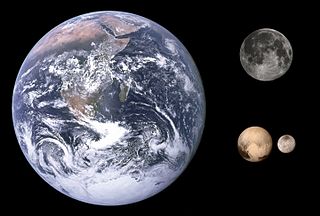
In astronomy, a double planet is a binary satellite system where both objects are planets, or planetary-mass objects, that share an orbital axis external to both planetary bodies.

A planet is a large, rounded astronomical body that is neither a star nor its remnant. The best available theory of planet formation is the nebular hypothesis, which posits that an interstellar cloud collapses out of a nebula to create a young protostar orbited by a protoplanetary disk. Planets grow in this disk by the gradual accumulation of material driven by gravity, a process called accretion. The Solar System has at least eight planets: the terrestrial planets Mercury, Venus, Earth, and Mars, and the giant planets Jupiter, Saturn, Uranus, and Neptune.

A terrestrial planet, telluric planet, or rocky planet, is a planet that is composed primarily of silicate rocks or metals. Within the Solar System, the terrestrial planets accepted by the IAU are the inner planets closest to the Sun: Mercury, Venus, Earth and Mars. Among astronomers who use the geophysical definition of a planet, two or three planetary-mass satellites – Earth's Moon, Io, and sometimes Europa – may also be considered terrestrial planets. The large rocky asteroids Pallas and Vesta are sometimes included as well, albeit rarely. The terms "terrestrial planet" and "telluric planet" are derived from Latin words for Earth, as these planets are, in terms of structure, Earth-like. Terrestrial planets are generally studied by geologists, astronomers, and geophysicists.

A natural satellite is, in the most common usage, an astronomical body that orbits a planet, dwarf planet, or small Solar System body. Natural satellites are colloquially referred to as moons, a derivation from the Moon of Earth.
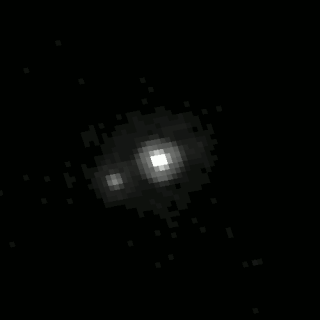
Orcus is a large trans-Neptunian object with a large moon, Vanth. It has a diameter of 870 to 960 km, the size of or somewhat smaller than the Inner Solar System dwarf planet Ceres. Orcus is generally accepted by astronomers as a dwarf planet, although there is some doubt. The surface of Orcus is relatively bright with albedo reaching 23 percent, neutral in color and rich in water ice. The ice is predominantly in crystalline form, which may be related to past cryovolcanic activity. Other compounds like methane or ammonia may also be present on its surface. Orcus was discovered by American astronomers Michael Brown, Chad Trujillo, and David Rabinowitz on 17 February 2004.

Michael E. Brown is an American astronomer, who has been professor of planetary astronomy at the California Institute of Technology (Caltech) since 2003. His team has discovered many trans-Neptunian objects (TNOs), including the dwarf planet Eris, which was originally thought to be bigger than Pluto, triggering a debate on the definition of a planet.
The naming of moons has been the responsibility of the International Astronomical Union's committee for Planetary System Nomenclature since 1973. That committee is known today as the Working Group for Planetary System Nomenclature (WGPSN).
The definition of the term planet has changed several times since the word was coined by the ancient Greeks. Greek astronomers employed the term ἀστέρες πλανῆται, 'wandering stars', for star-like objects which apparently moved over the sky. Over the millennia, the term has included a variety of different celestial bodies, from the Sun and the Moon to satellites and asteroids.
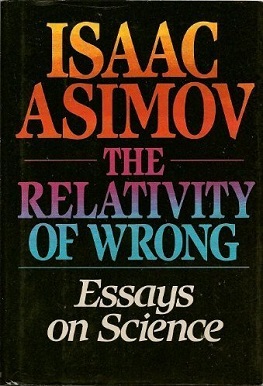
The Relativity of Wrong is a 1988 collection of seventeen essays on science by American writer and scientist Isaac Asimov. The book explores and contrasts the viewpoint that "all theories are proven wrong in time", arguing that there exist degrees of wrongness.

The following outline is provided as an overview of and topical guide to astronomy:

A dwarf planet is a small planetary-mass object that is in direct orbit around the Sun, massive enough to be gravitationally rounded, but insufficient to achieve orbital dominance like the eight classical planets of the Solar System. The prototypical dwarf planet is Pluto, which was regarded as a planet before the "dwarf" concept was adopted in 2006.

The International Astronomical Union (IAU) defined in August 2006 that, in the Solar System, a planet is a celestial body that:

Discovery and exploration of the Solar System is observation, visitation, and increase in knowledge and understanding of Earth's "cosmic neighborhood". This includes the Sun, Earth and the Moon, the major planets Mercury, Venus, Mars, Jupiter, Saturn, Uranus, and Neptune, their satellites, as well as smaller bodies including comets, asteroids, and dust.
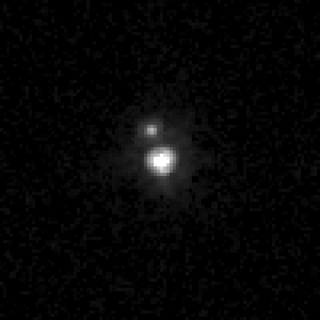
Vanth is a natural satellite or moon of the trans-Neptunian dwarf planet 90482 Orcus. It was discovered by Michael Brown and Terry-Ann Suer using images taken by the Hubble Space Telescope on 13 November 2005. The moon has a diameter of 443 km (275 mi), making it about half the size of Orcus and the third-largest moon of a trans-Neptunian object. Vanth is massive enough that it shifts the barycenter outside of Orcus, forming a binary system in which the two bodies revolve around the barycenter, much like the Pluto–Charon system. It is hypothesized that both systems formed similarly, most likely by a giant impact early in the Solar System's history. In contrast to Orcus, Vanth has a darker and slightly redder surface that apparently lacks exposed water ice, resembling primordial Kuiper belt objects.
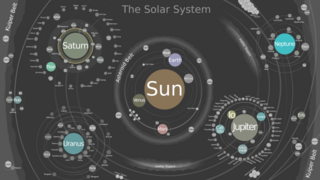
The following outline is provided as an overview of and topical guide to the Solar System:

Historical models of the Solar System began during prehistoric periods and are updated to this day. The models of the Solar System throughout history were first represented in the early form of cave markings and drawings, calendars and astronomical symbols. Then books and written records became the main source of information that expressed the way the people of the time thought of the Solar System.
The International Union of Geological Sciences (IUGS) is the internationally recognized body charged with fostering agreement on nomenclature and classification across geoscientific disciplines. However, they have yet to create a formal definition of the term planet. As a result, there are various geophysical definitions in use among professional geophysicists, planetary scientists, and other professionals in the geosciences. Many professionals opt to use one of several of these geophysical definitions instead of the definition voted on by the International Astronomical Union.